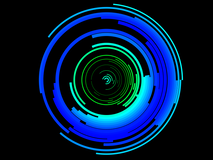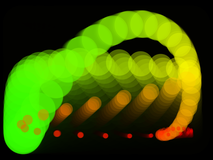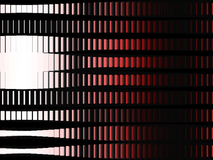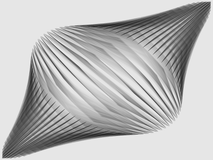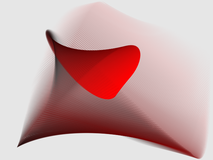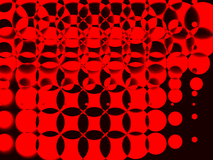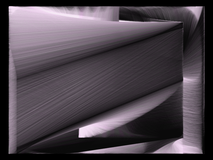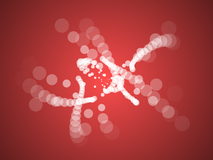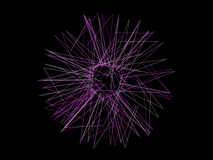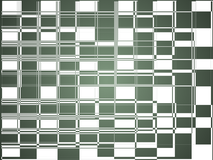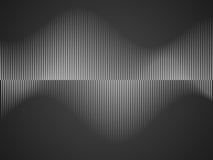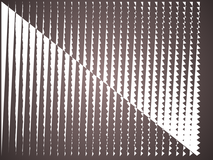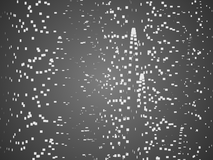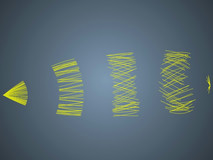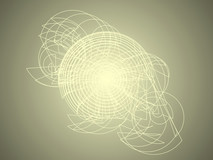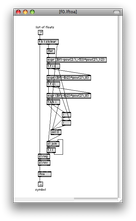A very simple SuperCollider drone instrument I wrote for a friend. The GUI is automatically generated from the node proxy using the .edit method. Most of the code is defining specs (min, max curve, stepsize and default values) for all the parameters. The synthesis part is very simple - just an oscillator going through a reverb and the oscillator is frequency, phase and amplitude modulated by other oscillators.
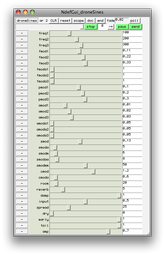
(
//redFrik 2011
s.waitForBoot{
Spec.add(\freq1, #[20, 10000, \exp, 0, 100]);
Spec.add(\freq2, #[20, 10000, \exp, 0, 200]);
Spec.add(\freq3, #[20, 10000, \exp, 0, 300]);
Spec.add(\fmod1, #[0.001, 100, \exp, 0, 0.11]);
Spec.add(\fmod2, #[0.001, 100, \exp, 0, 0.22]);
Spec.add(\fmod3, #[0.001, 100, \exp, 0, 0.33]);
Spec.add(\fmoda1, #[0, 100, \lin, 0, 1]);
Spec.add(\fmoda2, #[0, 100, \lin, 0, 1]);
Spec.add(\fmoda3, #[0, 100, \lin, 0, 1]);
Spec.add(\pmod1, #[0.001, 100, \exp, 0, 0.1]);
Spec.add(\pmod2, #[0.001, 100, \exp, 0, 0.2]);
Spec.add(\pmod3, #[0.001, 100, \exp, 0, 0.3]);
Spec.add(\amod1, #[0.001, 100, \exp, 0, 0.01]);
Spec.add(\amod2, #[0.001, 100, \exp, 0, 0.02]);
Spec.add(\amod3, #[0.001, 100, \exp, 0, 0.03]);
Spec.add(\amoda1, #[0, 10, \lin, 0, 0.05]);
Spec.add(\amoda2, #[0, 10, \lin, 0, 0.05]);
Spec.add(\amoda3, #[0, 10, \lin, 0, 0.05]);
Spec.add(\smod, #[0.001, 100, \exp, 0, 0.13]);
Spec.add(\smoda, #[0, 100, \lin, 0, 5]);
Spec.add(\smodm, #[0, 100, \lin, 0, 6]);
Spec.add(\smodaa, #[0, 100, \lin, 0, 8]);
Spec.add(\smodmm, #[0, 100, \lin, 0, 50]);
Spec.add(\cmod, #[0.001, 100, \exp, 0, 1.2]);
Spec.add(\cmoda, #[0, 10, \lin, 0, 0.6]);
Spec.add(\room, #[0, 300, \lin, 1, 20]);
Spec.add(\reverb, #[0, 30, \lin, 0, 5]);
Spec.add(\damp, #[0, 1, \lin, 0, 1]);
Spec.add(\input, #[0, 1, \lin, 0, 0.5]);
Spec.add(\spread, #[0, 100, \lin, 0, 25]);
Spec.add(\dry, #[0, 1, \lin, 0, 0]);
Spec.add(\early, #[0, 1, \lin, 0, 1]);
Spec.add(\tail, #[0, 1, \lin, 0, 1]);
Ndef(\droneSines).play;
Ndef(\droneSines, {|freq1= 100, freq2= 200, freq3= 300, fmod1= 0.11, fmod2= 0.22, fmod3= 0.33, fmoda1= 1, fmoda2= 1, fmoda3= 1, pmod1= 0.1, pmod2= 0.2, pmod3= 0.3, amod1= 0.01, amod2= 0.02, amod3= 0.03, amoda1= 0.05, amoda2= 0.05, amoda3= 0.05, smod= 0.13, smoda= 5, smodm= 6, smodaa= 8, smodmm= 50, cmod= 1.2, cmoda= 0.6, room= 20, reverb= 5, damp= 1, input= 0.5, spread= 25, dry= 0, early= 1, tail= 1, amp= 0.7|
Limiter.ar(LeakDC.ar(GVerb.ar(Splay.ar(SinOsc.ar([freq1, freq2, freq3]+SinOsc.ar([fmod1, fmod2, fmod3], 0, [fmoda1, fmoda2, fmoda3]), SinOsc.ar([pmod1, pmod2, pmod3], 0, 2pi), SinOsc.ar([amod1, amod2, amod3], 0, [amoda1, amoda2, amoda3])), SinOsc.ar(SinOsc.ar(SinOsc.ar(smod, 0, smoda, smodm), 0, smodaa, smodmm), 0, 1, 1), amp, SinOsc.ar(cmod, 0, cmoda)), room, reverb, damp, input, spread, dry, early, tail)));
});
Ndef(\droneSines).edit;
s.meter;
};
)
//Ndef(\droneSines).clear;
Ndef(\droneSines).stop;
//--save a preset
Ndef(\droneSines).nodeMap.writeArchive("~/Desktop/pset1.txt".standardizePath)
//--recall a preset
Ndef(\droneSines).nodeMap= Object.readArchive("~/Desktop/pset1.txt".standardizePath)
//--scramble settings
(
Ndef(\droneSines).set(\amp, 0.05);
Ndef(\droneSines).controlKeys.do{|k|
if(k!=\amp, {
Ndef(\droneSines).set(k, k.asSpec.map(1.0.rand));
});
};
)
Another 30 days of daily experiments. This time with Cairo 2D and Cinder + SuperCollider for sound. One very simple sketch per day to learn.
pakt29
Ndef(\wrap).play
(
Ndef(\wrap, {var n= 29; Splay.ar({|i|
var w= i+LFSaw.ar(i+1*SinOsc.ar(0.1, i/n*2pi, 1, 0.1), 0, 2, 2);
Saw.ar(340+LFSaw.ar(0.1, i/n, 10, 10).round(20)+i)%Saw.ar(60+w, SinOsc.ar(0.01, i/n*2pi, 2, 2.05))*0.25;
}!n)});
)
Ndef(\wrap).stop
pakt28
Ndef(\round).play
(
Ndef(\round, {var n= 28; GVerb.ar(Limiter.ar(LeakDC.ar(Mix({|i|
var z= SinOsc.ar(i.linexp(0, n-1, 70, 1500), LFSaw.ar(i+1*5, 0, 0.5pi), LFSaw.ar(0.2+SinOsc.ar(i+1*0.001, 0, 0.5), i/n, 0.4).max(0))*SinOsc.ar(200+i, 0, SinOsc.ar(0.03, i+1, 0.5, 1))*SinOsc.ar(400+i, 0, SinOsc.ar(0.04, i+2, 0.5, 1))*SinOsc.ar(800+i, 0, SinOsc.ar(0.05, i+3, 0.5, 1));
Pan2.ar(z, i.linlin(0, n-1, -0.925, 0.925), 1/n);
}!n))), 3, 5, 0.2, 0.8, 20, 0.1)});
)
Ndef(\round).stop
pakt27
Ndef(\sweep).play
(
Ndef(\sweep, {var n= 9; GVerb.ar(Mix({|i|
var t= i/n;
var t2pi= t*2pi;
var f= 2**i*10+100;
var z= LeakDC.ar(VarSaw.ar(SinOsc.ar(i+1*0.005, SinOsc.ar(i+1*SinOsc.ar(0.05, t2pi, 0.2, 0.4), 0, 2pi), f*SinOsc.ar(0.002, t2pi, 0.3, 0.5), f), t, SinOsc.ar(i+1*0.006, t2pi, 0.4, 0.5), i.linlin(0, n-1, 0.4, 0.1)));
Pan2.ar(z, SinOsc.ar(0.015, t2pi, i.linlin(0, n-1, 0.99, 0.2)), 1/n);
}!n), 30, 5, 0.3, 0.8, 10)});
)
Ndef(\sweep).stop
pakt26
Ndef(\grid).play
(
Ndef(\grid, {var n= 8; Mix({|i|
var t= i/n;
var z= LeakDC.ar(VarSaw.ar(SinOsc.ar(VarSaw.ar(i+1*VarSaw.ar(0.048, 0, 0.5, 25, 150), t, 1/3, 150), VarSaw.ar(100+i, t, VarSaw.ar(0.024, t, 0.25, 0.475, 0.5))*pi, VarSaw.ar(0.012, t, 0.75, VarSaw.ar(0.064, t, 0.5, 25, 50), 200), VarSaw.ar(0.16, t, 2/3, VarSaw.ar(0.02, t, 0.5, 7.5).abs, 300)), t));
Pan2.ar(z, VarSaw.ar(0.02, t, 0.5), 1/n);
}!n)});
)
Ndef(\grid).stop
pakt25
Ndef(\wobble).play
(
Ndef(\wobble, {var n= 5; Mix({|i|
var z= SinOsc.ar(0, SinOsc.ar(60+(i*SinOsc.ar(0.004, 0, 0.8, 1)), i/n*2pi, SinOsc.ar(0, SinOsc.ar(1, 0, 2pi), SinOsc.ar(0.006), 2pi)), 1/n);
Pan2.ar(z, z);
}!n)});
)
Ndef(\wobble).stop
pakt24
Ndef(\swoop).play
(
Ndef(\swoop, {var n= 24; Mix({|i|
var t= i/n;
var f= SinOsc.ar(0.01, t*0.5pi).exprange(i*22+100, i*44+1000);
var a= SinOsc.ar(0.05*t, t*2pi, 0.15).max(0);
var z= RLPF.ar(GrayNoise.ar(a), f*(a+1), 1.4-a-t);
Pan2.ar(z, LFTri.ar(0.05, t*4, 0.95));
}!n)});
)
Ndef(\swoop).stop
pakt23
Ndef(\sway).play
(
Ndef(\sway, {var n= 23; LeakDC.ar(Splay.ar({|i|
var t= i/n;
var f= t.linexp(0, 1, LFTri.ar(0.04, t*4, 400, 600), LFTri.ar(0.03, t*4, 400, 600));
var a= SinOsc.ar(SinOsc.ar(0.02, t*pi, 0.5), 0, 0.5).max(0);
SinOsc.ar(f+SinOsc.ar(f, 0, f*a), LFTri.ar(SinOsc.ar(t+0.01, t, 20), t*4, 4pi), a)
}!n))});
)
Ndef(\sway).stop
pakt22
Ndef(\blob).play
(
Ndef(\blob, {var n= 33; Mix({|i|
var t= i/n*2pi;
Pan2.ar(
LeakDC.ar(SinOsc.ar(Pulse.ar(0.0625, 2/3).range(0.0625, 0.125), SinOsc.ar(Pulse.ar(i+1, Pulse.ar(i+1*0.125, 0.4, 1/3, 0.5), i+1*n, i+1*n*2), t, SinOsc.ar(SinOsc.ar(0.0625, t), t, 2pi)), SinOsc.ar(i+1*0.125, t, i.linexp(0, n-1, 3/n, 0.001)))),
SinOsc.ar(0.125, t, i.linlin(0, n-1, 0, 0.95))
)
}!n)});
)
Ndef(\blob).stop
pakt21
Ndef(\flush).play
(
Ndef(\flush, {var a= {|i| 2.pow(i)}!7; Mix(
Pan2.ar(
Resonz.ar(SinOsc.ar(0, GrayNoise.ar(a*30*pi), 0.5), a*300, SinOsc.ar(a*0.13, 0, 0.4, 0.5)),
SinOsc.ar(a*0.03, 0, 0.95)
)
)});
)
Ndef(\flush).stop
pakt20
Ndef(\veil).play
(
Ndef(\veil, {var n= 15; GVerb.ar(Mix({|i|
var t= i/n*2pi;
var f= SinOsc.ar(SinOsc.ar(i*0.015+0.015, t), t);
var a= SinOsc.ar(f*SinOsc.ar(i*0.15+0.15, t, 0.15, 0.3), t, 150, 300);
var b= SinOsc.ar(f*SinOsc.ar(i*0.15+0.15, t, 0.15, 0.5), t, 1500, 3000);
Pan2.ar(
BPF.ar(
Saw.ar(SinOsc.ar(f, t).exprange(a, b), SinOsc.ar(f, t, SinOsc.ar(0.015*t+0.15, t, 0.15).max(0))),
a+b*0.5,
0.15
),
i/(n-1)*2-1
);
}!n), 15, 1.5, 0.15)});
)
Ndef(\veil).stop
pakt19
Ndef(\bubbles).play
(
Ndef(\bubbles, {var n= 6;
GVerb.ar(Mix({|i|
var q= i/n*2pi;
var t= Impulse.ar(SinOsc.ar(SinOsc.ar(0.125, q, 0.5), 0, 1.5, 2), i/n);
Pan2.ar(
SinOsc.ar(
SinOsc.ar(0.01, q, SinOsc.ar(0.05, q, 50), 500),
Decay2.ar(t, 0.02, 0.2, SinOsc.ar(0.05, q, SinOsc.ar(0.01, 0, 8pi, 8pi))),
Decay2.ar(t, TRand.ar(0.003, 0.03, t), TRand.ar(0.05, 0.1, t), SinOsc.ar(0.08, q, 0.2, 0.05).max(0))
),
(i/(n-1))*2-1
);
}!n), 40, 2, 0.6);
});
)
Ndef(\bubbles).stop
pakt18
Ndef(\grey).play
(
Ndef(\grey, {Mix({|i|
var t= Impulse.ar(SinOsc.ar(0.1+(i*0.125), i/10*2pi+#[0, 0.1], 4, SinOsc.ar(0.01+(i*0.01), 0, 4, 12)));
Pan2.ar(
FreeVerb.ar(
BPF.ar(
GrayNoise.ar(
Decay2.ar(
t,
TRand.ar(0.005, 0.015, t),
TRand.ar(0.1, 0.15, t),
TRand.ar(0.35, 0.5, t)
)
),
SinOsc.ar(i+1*0.032, #[0, 0.1]+i).exprange(i+1*300, i+1*600),
SinOsc.ar(i+1*0.025, #[0, 0.1]+i).range(0.1, 1)
),
0.3
),
SinOsc.ar(0.1, #[0, 0.1]+i, 0.9)
);
}!10)});
)
Ndef(\grey).stop
pakt17
Ndef(\shades).play
(
Ndef(\shades, {Mix({|i|
var x= SinOsc.ar(0, SinOsc.ar(0.01*i+0.03, i, 2pi));
var y= SelectX.ar(x.range(0, 4), [WhiteNoise.ar, GrayNoise.ar, PinkNoise.ar, BrownNoise.ar]);
var z= Pan2.ar(y, x*0.4);
BPF.ar(Rotate2.ar(z[0], z[1], i/3*2-1), i+1*500, SinOsc.kr(0, SinOsc.ar(i*0.02+0.01, i, pi)).range(1, 10), 0.3);
}!4)});
)
Ndef(\shades).stop
pakt16
Ndef(\wheel).play
(
Ndef(\wheel, {Splay.ar(BPF.ar(PinkNoise.ar(1!3)*SinOsc.ar(VarSaw.ar(#[0.011, 0.012, 0.013], #[0, 0.1, 0.2], 0.5, VarSaw.ar(#[0.01, 0.02, 0.03], #[0, 0.1, 0.2]).exprange(5, 50), #[300, 303, 309]), CombN.ar(Saw.ar(#[3, 2.5, 1], 0.5pi).sum, 0.05, 0.05), 3), VarSaw.ar(#[0.021, 0.022, 0.023], #[0.2, 0.1, 0.3]).exprange(500, 2000), VarSaw.ar(#[0.031, 0.032, 0.033], #[0, 0.1, 0.2]).exprange(0.06, 0.6)))});
)
Ndef(\wheel).stop
pakt15
Ndef(\spin).play
(
Ndef(\spin, {GVerb.ar(Mix(Pan2.ar(Formlet.ar(LPF.ar(Saw.ar((5..1)*LFPulse.ar(SinOsc.ar(0.1, 0, 0.5, 1), 0.5, 0.5, 10, 50)+SinOsc.ar((6..2)*0.05).exprange(0.05, 50), 0.3), 300)+Impulse.ar((0..4)+SinOsc.ar((4..8)*0.02).exprange(0.3, 300)), (1..5)*SinOsc.ar((5..9)*0.05).exprange(200, 2000)*SinOsc.ar(SinOsc.ar((2..6)*0.1, 0, 0.1), 0, 0.1, 1), 0.001, 0.0015), SinOsc.ar(SinOsc.ar((3..7)*0.1, 0, 0.1)))))});
)
Ndef(\spin).stop
pakt14
Ndef(\interfere).play
(
Ndef(\interfere, {var a= #[3, 1, 5, 2]; Limiter.ar(Splay.ar(Formlet.ar(LFPulse.ar(a*100+SinOsc.ar(a, 0, a/20), 0, SinOsc.ar(a/10, 0, 0.45, 0.5), LFPulse.ar(a+a, 0, SinOsc.ar(a/10, 0, 0.45, 0.5), 0.1)), a*100+LFPulse.ar(a/2, 0, 0.5, a*SinOsc.ar(a/100, 0, 150, 200)), SinOsc.ar(a/30, 0, 0.01, 0.0125), SinOsc.ar(a/60, 0, 0.05, 0.055), 0.2)))});
)
Ndef(\interfere).stop
pakt13
Ndef(\pulse).play
(
Ndef(\pulse, {GVerb.ar(Splay.ar(Resonz.ar(LFPulse.ar(#[121, 232, 343]), LFPulse.ar(#[0.121, 0.232, 0.343]).exprange(LFPulse.ar(#[12.1, 23.2, 34.3]).range(80, 100), LFPulse.ar(#[1.21, 2.32, 3.43].reverse).range(800, 1000)).sum*LFPulse.ar(#[0.121, 0.232, 0.343]).range(0.5, 1), 0.3, 0.15)), 34, 3, 0.2)});
)
Ndef(\pulse).stop
pakt12
Ndef(\waves).play
(
Ndef(\waves, {var n= 3; Mix({|i|
var z= VarSaw.ar(i+1*0.01, 0, 0.5, 5, VarSaw.ar(i+1*10, 0, 0.5, 0.5, 10));
var w= VarSaw.ar(i+1*VarSaw.ar(i+1*0.001, 0, 0.5, z, z*z), 0, 0.5, 0.5, 0.5);
Pan2.ar(
SinOsc.ar(0, VarSaw.ar(i+1*w*100, 0, w, 2pi), VarSaw.ar(i+1*w*0.1, 0, w, 0.5)),
i.linlin(0, n-1, -0.9, 0.9),
2/n
)
}!n)});
)
Ndef(\waves).stop
pakt11
Ndef(\hail).play
(
Ndef(\hail, {Splay.ar(Ringz.ar(SinOsc.ar(#[0.000101, 0.000202, 0.000303, 0.000404, 0.000505, 0.000606], SinOsc.ar(#[101, 202, 303, 404, 505, 606], 0, SinOsc.ar(#[0.0101, 0.0202, 0.0303, 0.0404, 0.0505, 0.0606], 0, pi)))*VarSaw.ar(#[1.01, 2.02, 3.03, 4.04, 5.05, 6.06], #[0.101, 0.202, 0.303, 0.404, 0.505, 0.606], SinOsc.ar(#[0.00101, 0.00202, 0.00303, 0.00404, 0.00505, 0.00606], 0, 0.5, 0.5)), #[1010, 2020, 3030, 4040, 5050, 6060], SinOsc.ar(#[10.1, 20.2, 30.3, 40.4, 50.5, 60.6], 0, 0.1, 0.2), 0.2))});
)
Ndef(\hail).stop
pakt10
Ndef(\rain).play
(
Ndef(\rain, {
var n= 30;
Mix({|i|
var z= SinOsc.ar(i+1*0.01, 0, 0.001);
var f= i*100+100+SinOsc.ar(0.0123+z, i/n*2pi).exprange(1, 30);
var q= SinOsc.ar(0.0234+z, i/n*2pi, 0.3, 0.7);
var p= SinOsc.ar(0.0345+z, i/n*2pi);
var a= SinOsc.ar(0.0456+z, i/n*2pi, 0.4, 0.45);
var x= HPF.ar(BPF.ar(HPF.ar(ClipNoise.ar(2)*Crackle.ar(SinOsc.ar(0.0123+z, i/n*2pi, 0.1, 1.8))), f, q));
Pan2.ar(x, p, a);
}.dup(n));
});
)
Ndef(\rain).stop
pakt09
Ndef(\snow).play
(
Ndef(\snow, {
Mix({|i|
var m= SinOsc.ar(0.005, i/5*2pi, 2pi);
var p= WhiteNoise.ar(SinOsc.ar(i*5000+5000)*SinOsc.ar(i*500+500)*SinOsc.ar(i*50+50)*SinOsc.ar(i*5+5));
Pan2.ar(SinOsc.ar(p, p*m, p), p, 0.5);
}.dup(5));
});
)
Ndef(\snow).stop
pakt08
Ndef(\redqueen3).play
(
Ndef(\redqueen3, {GVerb.ar(LeakDC.ar(
Saw.ar(
Saw.ar([100, 101]+Saw.ar([102, 103], Saw.ar([4, 5], Saw.ar([1, 2], 6, 7).sum).sum).sum).exprange(Saw.ar(1/12, 4, 50), Saw.ar(1/8, 3, Saw.ar(1/16, 4, 65))),
Saw.ar([21, 20], Saw.ar([40, 41], 0, 0.1), 0.2)
)), 60, 4, 0.5, 0.5, 5, 0.5, 0.5, 0.75)});
)
Ndef(\redqueen3).stop
pakt07
Ndef(\redqueen2).play
(
Ndef(\redqueen2, {GVerb.ar(LeakDC.ar(
SinOsc.ar(
SinOsc.ar(
SinOsc.ar(
SinOsc.ar(
SinOsc.ar(
SinOsc.ar(
SinOsc.ar(
1,
0,
2,
SinOsc.ar(1/2).exprange(1, 2)
),
0,
8,
SinOsc.ar(1/4).exprange(4, 8)
),
0,
32,
SinOsc.ar(1/8).exprange(16, 32)
),
0,
128,
SinOsc.ar(1/16).exprange(64, 128)
),
0,
512,
SinOsc.ar(1/32).exprange(256, 512)
),
0,
2048,
SinOsc.ar(1/64).exprange(1024, 2048)
), 0, 0.1)
), 16, 8, 0.75, 0.5)});
)
Ndef(\redqueen2).stop
pakt06
Ndef(\redqueen).play
(
Ndef(\redqueen, {GVerb.ar(LeakDC.ar(SinOsc.ar(SinOsc.ar([1/16, 1/12], 0, 5), SinOsc.ar(0, SinOsc.ar([SinOsc.ar(3, 0, 5, 12), SinOsc.ar(4, 0, 4, 16)], SinOsc.ar([SinOsc.ar(1/64, SinOsc.ar(0.5, 0, pi)).exprange(1, 30), SinOsc.ar(1/48, SinOsc.ar(0.75, 0, pi)).exprange(1, 30)], SinOsc.ar(SinOsc.ar(1/32, 0, 4), 0, 2pi), SinOsc.ar([1/6, 1/8], 0, 0.5pi, 2pi)), SinOsc.ar([1/3, 2/3], 0, 0.5pi, SinOsc.ar(1/8, 0, 0.5pi, 2pi))), SinOsc.ar([4/3, 3/4], 0, 0.5pi, SinOsc.ar([SinOsc.ar(1/256).exprange(80, 800), SinOsc.ar(1/256).exprange(80.8, 808)], 0, 0.5pi, 2pi)))))*0.05, 10, 3, 0.5, 0.5)});
)
Ndef(\redqueen).stop
pakt05
Ndef(\noises).play
(
Ndef(\noises, {
var freq= SinOsc.ar(SinOsc.ar((4..0)/150+SinOsc.ar((0..4)/18, 0, 0.8)), SinOsc.ar((0..4)/80+SinOsc.ar((0..4)/20, 0, 0.1), 0, 2pi)).exprange(100, 1000);
var rq= SinOsc.ar(SinOsc.ar((0..4)/6+SinOsc.ar((0..4)/19, 0, 0.7), SinOsc.ar((4..0)/5+SinOsc.ar((4..0)/2, 0, 0.1), 0, 2pi))).exprange(0.4, 4);
Splay.ar(BPF.ar(BPF.ar(ClipNoise.ar(1!5), freq, rq), freq, rq), 0.85);
});
)
Ndef(\noises).stop
pakt04
Ndef(\lines).play
(
Ndef(\lines, {Splay.ar(LeakDC.ar(SinOsc.ar([0.033, 0.066, 0.055, 0.044], SinOsc.ar([0.12, 0.13, 0.11, 0.14]*SinOsc.ar([0.151, 0.152, 0.153, 0.154], SinOsc.ar([5, 4, 3, 2], 0, 2pi), SinOsc.ar([0.043, 0.053, 0.063, 0.073], 0, [80, 60, 40, 100])), SinOsc.ar(([60, 64, 67, 71]+SinOsc.ar([0.024, 0.025, 0.026, 0.027], SinOsc.ar([0.01, 0.02, 0.03, 0.04], 0, pi), 1).round).midicps, 0, 2pi)), 0.2)))})
)
Ndef(\lines).stop
pakt03
Ndef(\varsaws).play
(
Ndef(\varsaws, {GVerb.ar(CombC.ar(VarSaw.ar(SinOsc.ar([0.1, 0.11], 0, 5, 100+SinOsc.ar([0.05, 0.055], 0, 50, 50).round(50)), 0, SinOsc.ar([0.2, 0.22], 0, 0.5, SinOsc.ar([0.3, 0.33], 0, 0.1, 0.5)), 0.1), 1.01, SinOsc.ar([0.4, 0.44], 0, 0.01, 1), 8), 80, 5, 0.9)})
)
Ndef(\varsaws).stop
pakt02
Ndef(\saws).play
(
Ndef(\saws, {Splay.ar(BPF.ar(LeakDC.ar(Saw.ar(SinOsc.ar((0..5)+1*0.02, SinOsc.ar((0..5)+1*101+300, 0, 2pi+SinOsc.ar(0.01, 0, 0.5*pi)), 400, 700))), SinOsc.ar((0..5)+1*0.004, 0, 100, 400), SinOsc.ar((0..5)+1*0.006, 0, 0.4, 0.8)))})
)
Ndef(\saws).stop
pakt01
Ndef(\moreSines).play
(
Ndef(\moreSines, {LeakDC.ar(Splay.ar(SinOsc.ar((0..20)/70+0.01, SinOsc.ar((0..20)+1*50+50+SinOsc.ar((0..20)+1/30), 0, 2pi), SinOsc.ar((0..20)+1/80, (0..20)/40, 0.2).max(0))))})
)
Ndef(\moreSines).stop
pakt00
Ndef(\sines).play
(
Ndef(\sines, {GVerb.ar(Splay.ar(SinOsc.ar([100, 200, 300]+SinOsc.ar([0.11, 0.22, 0.33]), SinOsc.ar([0.1, 0.2, 0.3], 0, 2pi), 0.1+SinOsc.ar([0.01, 0.02, 0.03], 0, 0.05)), SinOsc.ar(SinOsc.ar(SinOsc.ar(0.13, 0, 5, 6), 0, 8, 50), 0, 1, 1), 0.7, SinOsc.ar(1.2, 0, 0.6)), 20, 5, 1, 0.5, 25, 0, 1, 1)})
)
Ndef(\sines).stop
Updates:
- 120212: I ported them all to Processing.
- 120617: Rendered 1min MP3 excerpts. Attached below under the code snippets.
- 180629: Ported them all to p5js.
clean-up #30:
As the last thing for this month-of-cleaning-up-old-code-and-taking-care-of-forgotten-projects, I finally wrote some methods that I had been planning for a long time. They add support for discrete worlds to my redUniverse quark.
It's all fairly simple.
In a 2 dimensional world there are 8 neighbouring cells/locations. The surroundings method returns them.
a= RedWorld(RedVector[100, 200]) //a 2D world
a.surroundings
[ [ -1, -1 ], [ -1, 0 ], [ -1, 1 ], [ 0, -1 ], [ 0, 1 ], [ 1, -1 ], [ 1, 0 ], [ 1, 1 ] ]
And in a 3 dimensional world, the number of surrounding cells grows to 26. That is 3 * 3 * 3 - 1 where the minus one is the [0, 0] location.
a= RedWorld(RedVector[100, 200, 300]) //a 3D world
a.surroundings
[ [ -1, -1, -1 ], [ -1, -1, 0 ], [ -1, -1, 1 ], [ -1, 0, -1 ], [ -1, 0, 0 ], [ -1, 0, 1 ], [ -1, 1, -1 ], [ -1, 1, 0 ], [ -1, 1, 1 ], [ 0, -1, -1 ], [ 0, -1, 0 ], [ 0, -1, 1 ], [ 0, 0, -1 ], [ 0, 0, 1 ], [ 0, 1, -1 ], [ 0, 1, 0 ], [ 0, 1, 1 ], [ 1, -1, -1 ], [ 1, -1, 0 ], [ 1, -1, 1 ], [ 1, 0, -1 ], [ 1, 0, 0 ], [ 1, 0, 1 ], [ 1, 1, -1 ], [ 1, 1, 0 ], [ 1, 1, 1 ] ]
And the numbers for 4, 5 and 6 dimensional worlds (not that I ever used >3) are 80, 242, 728 respectively. (A RedWorld can have any number of dimensions.)
Also it is possible to not only get the directly adjacent cell, but neighbours further away. This example bumps up the surroundingArea variable from the default 1 to 2. Now the surroundings are all the cells next to and two steps away from [0, 0].
a= RedWorld(RedVector[100, 200]) //a 2F world
a.surroundingArea= 2
a.surroundings
[ [ -2, -2 ], [ -2, -1 ], [ -2, 0 ], [ -2, 1 ], [ -2, 2 ], [ -1, -2 ], [ -1, -1 ], [ -1, 0 ], [ -1, 1 ], [ -1, 2 ], [ 0, -2 ], [ 0, -1 ], [ 0, 1 ], [ 0, 2 ], [ 1, -2 ], [ 1, -1 ], [ 1, 0 ], [ 1, 1 ], [ 1, 2 ], [ 2, -2 ], [ 2, -1 ], [ 2, 0 ], [ 2, 1 ], [ 2, 2 ] ]
That is 24 neighbour locations per single cell in a 2D world.
So the surroundings method only give relative positions and the size of the neighbourhood. Not so useful. But there are the two other methods called surroundingLocations and neighbours that is what one should use. surroundingLocations takes an object and returns a list of locations depending on the current surroundings.
a= RedWorld(RedVector[100, 200]) //a 2D world
b= RedObject(a, RedVector[10, 20]) //an object at location [10, 20]
a.surroundingLocations(b) //get the surrounding locations of object b
[ RedVector[ 9, 19 ], RedVector[ 9, 20 ], RedVector[ 9, 21 ], RedVector[ 10, 19 ], RedVector[ 10, 21 ], RedVector[ 11, 19 ], RedVector[ 11, 20 ], RedVector[ 11, 21 ] ]
Last the neighbours method that returns an array of any nearby objects.
a= RedWorld(RedVector[100, 200]) //a 2D world
b= RedObject(a, RedVector[10, 20]) //an object at location [10, 20]
c= RedObject(a, RedVector[11, 21]) //an object at location [11, 21]
a.neighbours(b) //get the neighbouring objects of object b
[ a RedObject ]
The different worlds deals with border conditions differently. RedWorld wraps all the locations around and RedWorld3 filters out locations. Compare...
a= RedWorld(RedVector[100, 200]) //a 2D world without borders
b= RedObject(a, RedVector[0, 0]) //an object at upper left corner location [0, 0]
a.surroundingLocations(b) //get the surrounding locations of object b
[ RedVector[ 99, 199 ], RedVector[ 99, 0 ], RedVector[ 99, 1 ], RedVector[ 0, 199 ], RedVector[ 0, 1 ], RedVector[ 1, 199 ], RedVector[ 1, 0 ], RedVector[ 1, 1 ] ]
a= RedWorld3(RedVector[100, 200]) //a 2D world with borders
b= RedObject(a, RedVector[0, 0]) //an object at upper left corner location [0, 0]
a.surroundingLocations(b) //get the surrounding locations of object b
[ RedVector[ 0, 1 ], RedVector[ 1, 0 ], RedVector[ 1, 1 ] ]
The neighbours method is quite slow at the moment, but I hope to be able to speed it up considerably later on.
Anyway, here is the complete SVN diff: sourceforge.net/p/quarks/code/1765/



